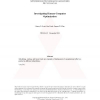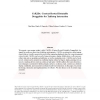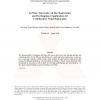CHI
2002
ACM
14 years 12 months ago
2002
ACM
Scheduling, routing, and layout tasks are examples of hardamount of computational effort expended on different subproblems. CHI?2002 This work may not be copied or reproduced in w...
CHI
2004
ACM
14 years 12 months ago
2004
ACM
In this demo we describe our ongoing efforts to build a robot that can collaborate with a person in hosting activities. We illustrate our current robot?s conversations, which incl...
CHI
2005
ACM
14 years 12 months ago
2005
ACM
We present a new popup widget, called CoR2Ds (Context-Rooted Rotatable Draggables), designed for multi-user direct-touch tabletop environments. CoR2Ds are interactive callout popu...
CHI
2005
ACM
14 years 12 months ago
2005
ACM
We introduce approximate query techniques for searching and analyzing two-dimensional data sets such as line or scatter plots. Our techniques allow users to explore a dataset by d...
CHI
2008
ACM
14 years 12 months ago
2008
ACM
The interoperability of disparate data types and sources has been a long standing problem and a hindering factor for the efficacy and efficiency in visual exploration applications...
CHI
2008
ACM
14 years 12 months ago
2008
ACM
We present a pair of experiments that explore the effects of tactile-feedback and direct vs. indirect pen input on pointing and crossing selection tasks. While previous work has d...
ICIP
2009
IEEE
15 years 17 days ago
2009
IEEE
Alice and Bob possess sequences xn and yn respectively and would like to compute d(xn , yn ) where d(., .) is a distortion measure. However, Alice and Bob do not trust each other ...



